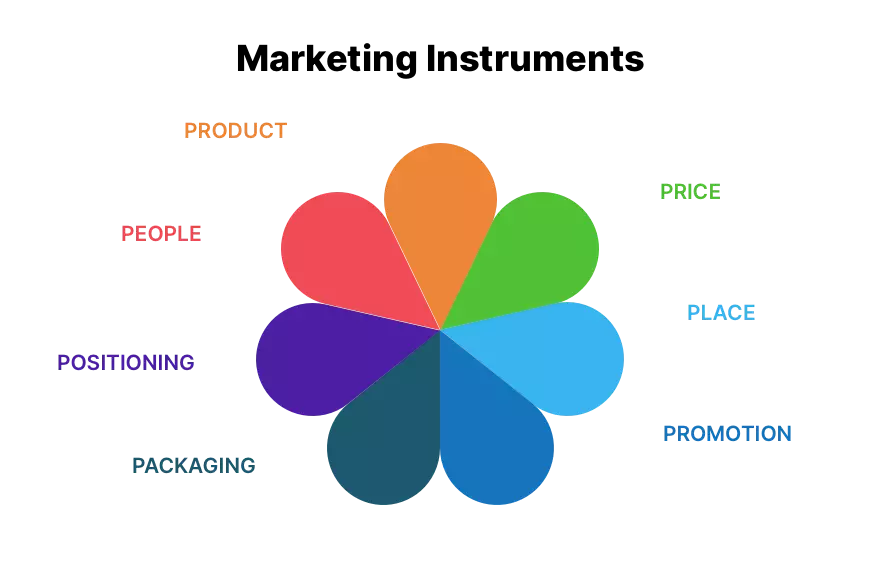The marketing instruments, consisting of the 4 or 7 Ps of marketing or the marketing mix, are a basic of marketing. What are the marketing instruments and how do they work?
The marketing instruments are the set of tactical marketing tools that the firm uses to actually implement its marketing strategy. The strategy tells us how the firm want to create customer value, build profitable customer relations, and capture value back in return. The marketing instruments consist of the tactical marketing tools used to actually produce the response the company wants in the target market. We refer to the marketing instruments as the 4 Ps of marketing, or the 7 Ps of marketing.

The 4 Ps of Marketing – The Marketing Instruments
The marketing instruments consist of the marketing mix elements, but what does the marketing mix consist of? It is composed of everything the firm can do to take influence on the demand for its offering. The many possibilities can be summarized and collected into four groups of variables: the 4 Ps. The 4 Ps stand for Product, Price, Place (Distribution) and Promotion. Let’s examine each of these elements more closely, before turning to their extension: the 7 Ps of the complete marketing instruments.
Product – Marketing Instruments
The product is the realisation of the customers’ needs and wants. It is the base of the value created for the customer. Product means the goods-and-services combination the firm offers to the target market. A product consists of all the elements it is composed of. Thus, a car is more than the car itself – it is the nuts and bolts, the spark plugs, and thousands of other parts. Also, the car does not come alone – it comes along with optional features, full after-sales service package, warranty and other components that are as much part of the product as the exhaust. Thus, the product is far more than the core product that you would think of – it is the complete package which surrounds the product.
Price – Marketing Instruments
The price is a part of the value exchange that occurs between the company and the customer. It is the amount of money customers must pay to obtain the product. However, the price is more than just the list price. It may be adjusted by discounts, negotiations, allowances or credit terms. These actions adjust the price to present competitive and economic conditions and bring the price in line with the customer’s perception of the value of the product. The customer’s value of the product should receive special consideration in setting the price. If the gap between customers’ perceptions and the price they have to pay for the product is too high, the entire marketing mix may prove useless.
Place (Distribution) – Marketing Instruments
The place must be thought of as distribution. Place, or distribution, refers to all company activities that make the product available to target consumers. That may happen through retailers, own dealers or any other distribution network. In the case of a car manufacturer, place refers to the large number of independently owned dealerships that sell the company’s models. These dealers keep an adequate inventory of cars, demonstrate and present them to potential customers, are responsible for negotiations, closing sales, as well as for after-sales service.
Promotion – Marketing Instruments
The company can create as much value for the target customers as it wants to. As long as this value is not communicated to these target customers they will never become actual customers. Thus, promotion refers to the activities that communicate the superior value and benefits of the product to target customers. Also, these activities aim to persuade target customers to buy the product.
However, promotion is more than advertising and sales. Companies may spend millions each year on advertising to tell consumers about the firm, its brands and its products. They may train sales staff to persuade potential buyers of the product, and they may rely on special promotion tactics, such as cash discounts and low financing rates. But especially nowadays, promotion must be understood as communication. Particularly in times of social media and modern technologies, exchange of information between consumers and the company as well as among consumers has become a crucial issue for any organization. Communication is more open and online than ever before and it has never been easier to step into peoples’ social life. The company should aim to become part of peoples’ lives, by communicating value with them instead of just to them. In a two-sided relationship, the firm should actively engage in exchanging value between itself and the customer instead of presenting that value only to the consumer.
Extension of the Marketing Mix – 7 Ps of Marketing
To get a full view on the marketing instruments, we need to investigate the 7 Ps of Marketing. In addition to the 4 Ps of marketing included in the classic marketing mix, the marketing instruments involve three more variables.
Packaging – Marketing Instruments
The fifth element in the marketing mix or marketing instruments is the packaging. Develop the habit of standing back and looking at every visual element in the packaging of your product or service through the eyes of a critical prospect. Remember, people form their first impression about you within the first 30 seconds of seeing you or some element of your company. Small improvements in the packaging or external appearance of your product or service can often lead to completely different reactions from your customers.
With regard to the packaging of your company, your product or service, you should think in terms of everything that the customer sees from the first moment of contact with your company all the way through the purchasing process.
Packaging refers to the way your product or service appears from the outside. Packaging also refers to your people and how they dress and groom. It refers to your offices, your waiting rooms, your brochures, your correspondence and every single visual element about your company. Everything needs to be taken into consideration to create healthy marketing instruments that work.
Positioning – Marketing Instruments
The sixth P of the 7 Ps of the marketing instruments is positioning. You should develop the habit of thinking continually about how you are positioned in the hearts and minds of your customers. How do people think and talk about you when you’re not present? How do people think and talk about your company? What positioning do you have in your market, in terms of the specific words people use when they describe you and your offerings to others?
Begin by determining the position you’d like to have. If you could create the ideal impression in the hearts and minds of your customers, what would it be? What would you have to do in every customer interaction to get your customers to think and talk about in that specific way? What changes do you need to make in the way interact with customers today in order to be seen as the very best choice for your customers of tomorrow?
People – Marketing Instruments
The final P of the 7 Ps of the marketing mix is people. People make the marketing instruments complete. Develop the habit of thinking in terms of the people inside and outside of your business who are responsible for every element of your sales, marketing strategies, and activities. To be successful in business, you must develop the habit of thinking in terms of exactly who is going to carry out each task and responsibility. In many cases, it’s not possible to move forward until you can attract and put the right person into the right position. Many of the best business plans ever developed sit on shelves today because the [people who created them] could not find the key people who could execute those plans.
When all elements of the 7 Ps of the marketing mix are implemented properly, the marketing instruments reach their full effectiveness and will lead to a successful business.






